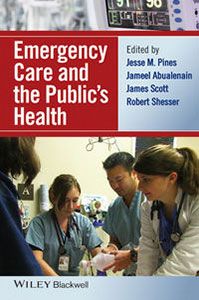
WASHINGTON (June 18, 2014) — Four George Washington University (GW) School of Medicine and Health Sciences (SMHS) faculty members published a new reference text, “Emergency Care and the Public’s Health.” The book explores how emergency care has evolved over the past five decades in the context of the complex relationship between emergency departments and broader public health, legal, economic, and social trends in the U.S.
“Emergency Care and the Public’s Health” provides a comprehensive overview of emergency care delivery in America, and glimpses into the emergency care systems across the world. It debunks common misconceptions of emergency care, detailing vital topics in emergency care such as information technology, telemedicine, workforce, preparedness response to disasters, and financial and legal issues.
Jesse M. Pines, M.D., director of the Office of Clinical Practice Innovation, Jameel Abualenain, M.D., assistant professor of emergency medicine, James Scott, M.D., professor of emergency medicine, and Robert Shesser, M.D., chair of the Department of Emergency Medicine, all at SMHS, wrote and edited the textbook, also authored by a multi-disciplinary team of physicians, researchers, lawyers, and front-line emergency care providers.
“Care delivered in emergency departments is one of the most effective yet misunderstood components of American healthcare today. Emergency departments deliver life-saving treatments, serve as an always-open resource for high quality care, and treat everyone regardless of whether they can pay,” said Pines, also a professor of emergency medicine at SMHS and professor of health policy at the Milken Institute School of Public Health at GW. “The book details how the emergency care system evolved, and how it might change in the coming years with the rollout of the Affordable Care Act. While mostly targeted to healthcare providers, administrators, and policymakers, the writing is clear and is designed to be readily accessible to anyone with an interest in understanding the intersection between emergency medicine and public health.”
In the coming years, the emergency care system is expected to change dramatically. This change includes the development of new diagnostic, therapeutic, and information technologies; a growing need to prepare and respond to emerging public health threats; the expansion of the role of allied health professionals to address the workforce crisis; novel expectations for care coordination; and the fundamental economics of emergency care under new payment models. In the context of these changes, Pines and his team hope to provide insight for those navigating the rapidly evolving health care system.
Please visit Amazon for more information on ordering the book.


